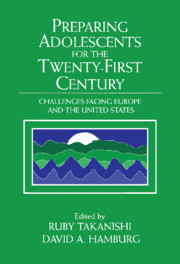Book contents
- Frontmatter
- Contents
- Contributors
- Foreword
- Preface
- 1 Meeting the essential requirements for healthy adolescent development in a transforming world
- 2 Adapting educational systems to young adolescents and new conditions
- 3 The impact of school reform for the middle grades: A longitudinal study of a network engaged in Turning Points–based comprehensive school transformation
- 4 Schooling for the middle years: Developments in Europe
- 5 The role of the school in comprehensive health promotion
- 6 Education for healthy futures: Health promotion and life skills training
- 7 HUMBIO: Stanford University's human biology curriculum for the middle grades
- 8 Education for living in pluriethnic societies
- 9 The economics of education and training in the face of changing production and employment structures
- 10 School-to-work processes in the United States
- 11 Finding common ground: Implications for policies in Europe and the United States
- Name index
- Subject index
1 - Meeting the essential requirements for healthy adolescent development in a transforming world
Published online by Cambridge University Press: 10 May 2010
- Frontmatter
- Contents
- Contributors
- Foreword
- Preface
- 1 Meeting the essential requirements for healthy adolescent development in a transforming world
- 2 Adapting educational systems to young adolescents and new conditions
- 3 The impact of school reform for the middle grades: A longitudinal study of a network engaged in Turning Points–based comprehensive school transformation
- 4 Schooling for the middle years: Developments in Europe
- 5 The role of the school in comprehensive health promotion
- 6 Education for healthy futures: Health promotion and life skills training
- 7 HUMBIO: Stanford University's human biology curriculum for the middle grades
- 8 Education for living in pluriethnic societies
- 9 The economics of education and training in the face of changing production and employment structures
- 10 School-to-work processes in the United States
- 11 Finding common ground: Implications for policies in Europe and the United States
- Name index
- Subject index
Summary
The problem of world transformation provides a vital context for viewing adolescent development. It is a very large canvas on which to paint. Yet we must try to understand it because adolescence is, in some ways, very different than it was in our long evolutionary past.
The turn of the twentieth century is a useful benchmark. In 1900, there were hardly any automobiles or household telephones; motion pictures were barely getting under way. There were no household radios, no airplanes, no televisions, no computers. What a difference a century makes! Indeed, now even the changes within a decade are dramatic by evolutionary and historical standards. Never before have such rapid and complex transformations occurred as in our lifetime.
The recent changes driven by technological opportunities have had a huge impact on the economy, on communities, and on families. We have rocketed into a new way of life within a couple of generations. And these changes have had powerful effects on the experience of growing up. Today' children are in a very different situation than their parents or grandparents – in some ways better, in some ways worse. We need to clarify what is better and what is worse – and how to shift the balance from worse toward better.
The human child is an ancient creature, shaped by many millennia of biological evolution in ways that pose critical requirements for adequate development. These essential requirements have to be met if the child is to grow and develop, to thrive and learn, and to pursue a vigorous, constructive, adaptable life.
- Type
- Chapter
- Information
- Preparing Adolescents for the Twenty-First CenturyChallenges Facing Europe and the United States, pp. 1 - 12Publisher: Cambridge University PressPrint publication year: 1997
- 1
- Cited by



